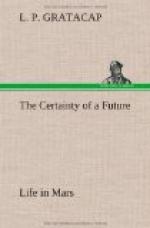As the surprising messages detailed in the following pages came by means of wireless telegraphy, I will dwell for an instant for the benefit of the non-scientific reader, upon the investigations made by my father and myself in this subject.
The installation of a wireless telegraphic station is not necessarily difficult. The progress made since my father and myself began these experiments has been, of course, considerable, and yet so far as I am able to ascertain the new devices in this direction were largely anticipated by us. The tuning of wireless messages by which the interception of messages is prevented was certainly forestalled by us, though in the communications with Mars herein detailed the ordinary [non-syntonic.—Editor] receiver was employed.
We employed an induction coil, emitted a wave by a spark, and had a wire rod [antenna.—Editor] which was in turn part of an induction coil. This was the sender (transmitter) and we could regulate the wave length so that a receiving wire adjusted for such a wave could only receive it. [There seems to be implied in these words an arrangement known as the Slaby-Arco system, which American readers have had described for them by M.A. Frederick, Collins, Sci. Amer., March 9 and Dec. 28, 1901.—Editor.] The receiver consisted of iron filings in which later carbon particles were added.
My father died in 1892 and we had not at the time of his death learned of Popoff’s microphone-coherer in which steel filings were mixed with carbon granules. The magnetic waves received at first by us presumably from Mars, and later, as the communications indisputably show, from that planet, were taken upon a Marconi receiver, or what was practically that.
My father became more and more interested in the direction of interplanetary research by means of the magnetic wave. He argued vehemently, buoyed up by his increasingly augmented hopes as our own experiments improved, that the electric wave through space moving in an ethereal fluid of the extremest purity would progress more rapidly than in our atmosphere, that the tension of such waves would be greater, that they could be so “heaped up” as he expressed it—(In the Slaby-Arco system an apparatus is employed consisting of a Ruhmkorff coil with a centrifugal mercury interrupter, by which a steeper wave front of the disruptive discharge is secured.—Editor)—that their reception over the almost impassable distances of space would be made possible.
This idea of piling up the waves was suggested by purely physical analogies. The enormous waves generated by severe storms upon the ocean travel farther than the smaller waves, and are less consecutively dissipated by the resistance of the water, the traction of its molecules and the occasional diversion of cross disturbances from other centers.
Again some experiments made invacuo upon a limited scale seemed to show the accuracy of his predictions. Through a glass tube one foot in diameter and ten feet long we sent magnetic waves both when the tube was filled with air and when it was exhausted. Our means of measuring the time required in both cases were quite inadequate—perhaps there was no appreciable difference—but the records in the latter case, secured upon a Morse register, were unmistakably more vigorous and audible.




